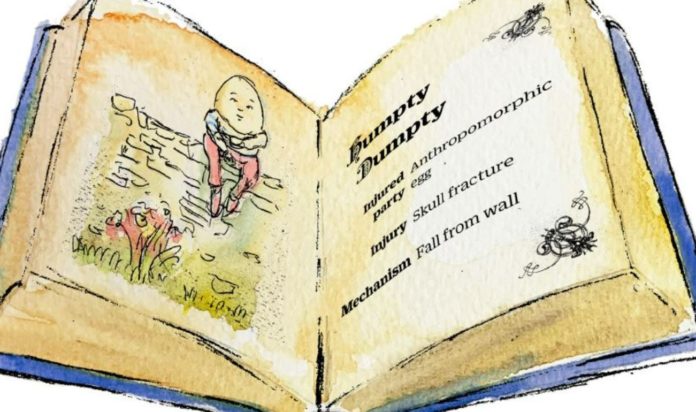What do Humpty Dumpty, Jack and Jill, and Five Little Monkeys all have in common? According to international research, each of these nursery rhymes can educate children and adults about brain injuries and possibly how to avoid them.
The study looked at injuries in Goosey Goosey Gander, Humpty Dumpty, It’s Raining, It’s Pouring, Jack and Jill, Ring a Ring o’ Roses, Rock-a-Bye Baby, and Five Little Monkeys, among other nursery rhymes. According to the author, nursery rhymes have the potential to provide essential insights into the biomechanics of head injuries, as well as an opportunity for parents and children to discuss how to best prevent injuries.
According to an expert, nursery rhymes can educate the importance of safe play and occupational dangers, which can assist both young and old lower their risk of brain injuries.
Declan Patton of the Children’s Hospital of Philadelphia’s Center for Injury Research and Prevention and Minds Matter Concussion Program investigated seven popular nursery rhymes that involved or were suspected of involving head injuries caused by falls.
Humans of all ages, five small monkeys, and an anthropomorphic egg were among the injured.
For example, the connections in structure and physical features, Humpty Dumpty, who famously experienced a great fall from a wall, has prompted research on chicken eggs to explore the biomechanics of head injuries in people.
Meanwhile, Jack and Jill may be able to shed light on sex-based differences in head injuries and the use of protective gear to prevent skull fractures.
“Jack’s head injury and unnecessary treatment with vinegar and brown paper might have been avoided if he had worn a helmet,” says Patton.
Rock-a- Bye Baby emphasizes the importance of height and impact surface in determining the possibility of a head injury following a fall. Patton warns that cradles’ crashworthiness is unclear and may be inadequate because they are not designed, tested, or certified for falls – from treetops or elsewhere. As a result, he advises that consumer products for children “should only be used for their intended purpose according to the manufacturer’s instructions”.
Falls from standing height, like in Ring of Ring o’ Roses, account for a fifth of all head injuries in children under the age of six. Children singing and dancing to this rhyme “should be at low risk of head injury,” according to Paton, but they should do so on energy-absorbing surfaces for added protection.
Falls from springy surfaces, such as mattresses, are also prevalent, as seen in Five Little Monkeys. While trampolines remain a common cause of brain injury in children and should always be used under adult supervision, Patton believes that “one of the best injury prevention methods is to avoid monkeying around”.
According to Patton, understanding the mechanics of falls can help determine the type of brain damage that may occur.
In Goosey Goosey Gander, for example, an elderly man is “taken by his left leg” and flung “down the stairs.” Although the assaulted man’s age is unknown, Patton points out that roughly half of all persons 65 and over who fall downstairs suffer a head injury.
The old man in It’s Raining, It’s Pouring most likely hurt his head when he fell out of bed. While the usefulness of bed rails and alarms is debatable, Patton believes that developments in home monitoring systems “might have helped to prevent the old man’s fall or at least detect the incident”.
According to Patton, these nursery rhymes have the potential to provide essential insights on the biomechanics of head injuries, as well as an opportunity for parents and children to talk about how to best prevent injuries.
He advises that future nursery rhyme writers “should bear in mind the risk factors associated with head injuries, especially when their characters might behave recklessly like jumping off a springy bed; might fall off a wall or down from a treetop; or are thrown down the stairs by unknown assailants.”
“In this way readers both young and old can be taught the importance of safe play and occupational hazards and thereby reduce their chances of a head injury,” he concludes.
Source: 10.1136/bmj-2021-068256
You were reading: Nursery rhymes can help teach the importance of safe play
